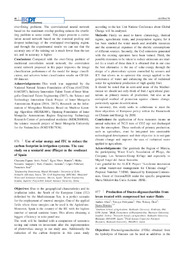Por favor, use este identificador para citar o enlazar este ítem:
https://hdl.handle.net/11000/31791Registro completo de metadatos
| Campo DC | Valor | Lengua/Idioma |
|---|---|---|
| dc.contributor.author | Chazarra-Zapata, Jesus | - |
| dc.contributor.author | Egea Pérez, Ramón | - |
| dc.contributor.author | Melian Navarro, Amparo | - |
| dc.contributor.author | RUIZ CANALES, ANTONIO | - |
| dc.contributor.author | López Peñalver, Francisco José | - |
| dc.contributor.other | Departamentos de la UMH::Ingeniería | es_ES |
| dc.date.accessioned | 2024-03-21T10:58:45Z | - |
| dc.date.available | 2024-03-21T10:58:45Z | - |
| dc.date.created | 2018-12-09 | - |
| dc.identifier.citation | Basic and Clinical Pharmacology and Toxicology (BCPT). V. 124, Issue S2, p. 48 | es_ES |
| dc.identifier.issn | 1742-7835 | - |
| dc.identifier.issn | 1742-7843 | - |
| dc.identifier.uri | https://hdl.handle.net/11000/31791 | - |
| dc.description.abstract | Objectives: Due to the geographical characteristics and its irradiation index, the South of the European Union (EU) delimited by the Mediterranean Sea, is a perfect scenario for the employment of renewal energies. One of the applied fields where these energies can be used is the Agriculture. Moreover, Spain is the country of the EU with the highest number of annual sunshine hours. This allows obtaining a biggest efficiency in solar panel use. The work will be finished with a comparison of economic saving and return on investment after the implementation of photovoltaic energy in our study area. Additionally the reduction of the carbon footprint in this cases study according to the last Unit Nations Conference about Global Change will be analyzed. Methods: Firstly we need to know climatology, termal regime, agroclimatic traits, and precipitation regime, for it has been studied the water needs and available resources and the economical expenses of the electric consumptions of different sources. Secondly, the Co2 emissions generated with the existing operation have been valued. Third, the possible measures to be taken to reduce emissions are studied As a result of these data it is obtained that in our case the best alternative is the use of solar energy through the design of a photovoltaic system controlled by sensors and ICT that allows us to optimize this energy applied to the governance of water and enhancing the use of reclaimed water for agricultural production of high quality fruit. It should be noted that in semi‐arid areas of the Mediterranean we should not only think of fruit / agricultural plantations as primary means of production, but also as an ecological method of protection against climate change, particularly against desertification. In summary, this study seeks to collaborate to meet the three objectives of European policy within the Framework on Climate and Energy by 2030. Conclusions: the application of these measures means an annual reduction of 782.5 tons of CO2 eqv not discharged into the atmosphere. These methods of primary production, such as agriculture, must be integrated into sustainable technological development and their objective is to mitigate climate change and improve the uses of reclaimed wáter applied to agriculture. | es_ES |
| dc.format | application/pdf | es_ES |
| dc.format.extent | 1 | es_ES |
| dc.language.iso | eng | es_ES |
| dc.publisher | Wiley | es_ES |
| dc.relation.ispartof | Americas Conference on Medical Imaging and Clinical Research (AMICR 2018), Panama, 23–25 December 2018 | es_ES |
| dc.rights | info:eu-repo/semantics/openAccess | es_ES |
| dc.rights | Attribution-NonCommercial-NoDerivatives 4.0 Internacional | * |
| dc.rights.uri | http://creativecommons.org/licenses/by-nc-nd/4.0/ | * |
| dc.subject | Solar energy | es_ES |
| dc.subject | Photovoltaic energy | es_ES |
| dc.subject | Semi-arid areas | es_ES |
| dc.subject | Desertification | es_ES |
| dc.subject | Irrigation systems | es_ES |
| dc.subject.other | CDU::6 - Ciencias aplicadas::63 - Agricultura. Silvicultura. Zootecnia. Caza. Pesca::631 - Agricultura. Agronomía. Maquinaria agrícola. Suelos. Edafología agrícola | es_ES |
| dc.title | Use of solar energy and ITC to reduce the carbon footprint in irrigation systems. The case study on a semiarid zone (Pliego) in the southeast of Spain | es_ES |
| dc.type | info:eu-repo/semantics/article | es_ES |
| dc.relation.publisherversion | https://doi.org/10.1111/bcpt.13173 | es_ES |

Ver/Abrir:
10.- Use of solar energy and ITC to reduce the Carbon footprint in irrigation systems (4).pdf
41,15 kB
Adobe PDF
Compartir:
 La licencia se describe como: Atribución-NonComercial-NoDerivada 4.0 Internacional.
La licencia se describe como: Atribución-NonComercial-NoDerivada 4.0 Internacional.
.png)